Petzyo Top Breed Guide
Australian Shepherd
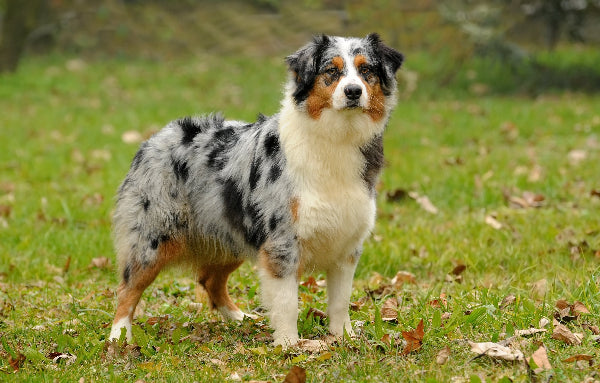
QUICK FACTS
Height: 46–58 cm (males); 43–53 cm (females)
Weight: 22–30 kg (males); 18–25 kg (females)
Lifespan: 12–15 years
Breed Group: Working Dog / Herding Group
Energy Level: Very High - needs daily physical and mental exercise
Grooming Needs: Moderate to Heavy - seasonal shedding spikes
- Breed Overview
- Physical & Appearance
- Personality
- Health & Diet
- Grooming & Care
- Cost & Ownership
The History of Australian Shepherds
Australian Shepherds might carry the name “Australian,” but their story starts far from the outback. In fact, this smart, high-drive breed was shaped more by American ranches than Aussie farmland.
Its name likely comes from its connection to Basque shepherds who came to the U.S. through Australia in the 1800s, bringing their herding dogs along. American farmers were impressed by these dogs’ intelligence, stamina, and herding instincts, and refined the breed into what we now know as the Aussie.
Their popularity skyrocketed in the mid-20th century when Australian Shepherds began performing in rodeos and western horse shows, wowing crowds with their agility and smarts.
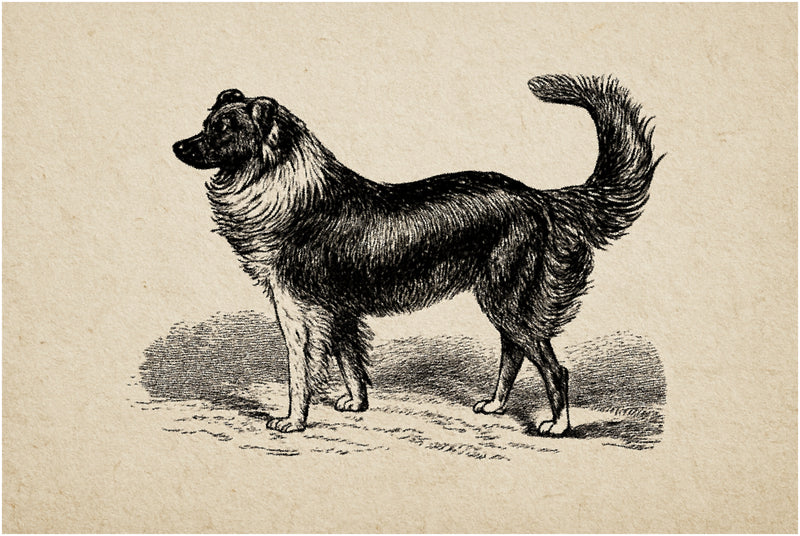
BREED SUMMARY
Australian Shepherds are medium-sized, athletic dogs known for their striking appearance and agile build. Males stand 46–58 cm and weigh 22–30 kg, while females measure 43–53 cm and weigh 18–25 kg. Their medium-length, weather-resistant double coat comes in vibrant patterns like Blue Merle, Red Merle, Black and White, Red and White, Black Tri-Colour, and Red Tri-Colour, often paired with expressive blue or amber eyes. With a balanced, muscular frame, high-set triangular ears, and naturally bobbed or full tails, Aussies are built for movement and endurance, making them a standout at dog parks and on trails.
These dogs are highly intelligent, energetic, and loyal, thriving on mental and physical challenges. Known for their playful “smile” and strong herding instincts, they excel in obedience, agility, and herding tasks, forming deep bonds with their owners. Aussies are protective yet not aggressive, though reserved with strangers, and require daily engagement to prevent restlessness or mischief. Without sufficient exercise or stimulation, their high-drive nature may lead to undesirable behaviors, making consistent training and activity essential for a happy, well-mannered companion.
Australian Shepherds are prone to specific health concerns, including drug sensitivities (MDR1 gene mutation), hip dysplasia, epilepsy, progressive retinal atrophy (PRA), collie eye anomaly, and deafness, particularly in merle-coated dogs with blue eyes. Regular vet checkups, vaccinations, parasite prevention, and early screenings (e.g., PennHip X-rays, hearing tests) are vital. Their diet should support their active lifestyle with 1.5–2.5 cups of high-quality, protein-rich kibble daily, featuring animal-based proteins, low-glycemic index (low-GI) ingredients like brown rice or broccoli, and Omega-3 and Omega-6 fats for coat and joint health. Portion control, slow-feed bowls, and constant fresh water help maintain their lean build and overall well-being.
FAQs About Australian Shepherd
Is an Australian Shepherd a good house dog?
Yes, if their energy is well managed. Australian Shepherds can thrive in homes when they’re mentally and physically stimulated daily. Without enough exercise or enrichment, they may become restless or develop problem behaviours like barking or herding furniture. Give them a job, a daily routine, and they’ll be a calm, loyal companion indoors.
Are Australian Shepherds high maintenance?
In some ways, yes. They need regular grooming (especially during shedding seasons), plenty of daily exercise, and ongoing training to stay happy. Their double coat doesn’t require fancy trims, but it does need weekly brushing. Mentally, they’re high-drive, so boredom is not an option.
Why are Australian Shepherds called Australians?
Despite the name, Australian Shepherds were actually developed in the United States, not Australia. The name likely comes from the breed's early association with Basque shepherds who came to the U.S. from Australia in the 1800s, bringing their herding dogs with them. American ranchers admired these dogs’ working ability and began refining the breed we now know as the Australian Shepherd. So, the "Australian" name is more about history and perception than true origin.
Can Australian Shepherds be left alone?
Not for too long. Aussies are people-oriented and need purpose. Leaving them alone for hours daily can lead to anxiety, boredom, or destructive behaviour. If you work full-time, consider doggy daycare, hiring a dog walker, or providing enrichment toys to keep your dog busy while you're away.
Coat type
Coat length
Physical & Appearance
Australian Shepherds are as striking in appearance as they are spirited in personality. Known for their expressive eyes, agile build, and even the occasional playful “smile,” Aussies are a breed with distinctive physical traits that support their hardworking nature.
They are medium-sized dogs with a balanced, muscular build. They’re slightly longer than they are tall, giving them a sleek, ground-covering stride. And they have a medium-length double coat that's weather-resistant, with straight to wavy in texture.
Standard Colours (Merle, Bi-Colour, and Tri-Colour)
If there’s one thing that sets the Aussie apart visually, it’s its coat. It comes in a range of stunning shades and patterns that turn heads at the dog park. The most common Australian Shepherd colours include:
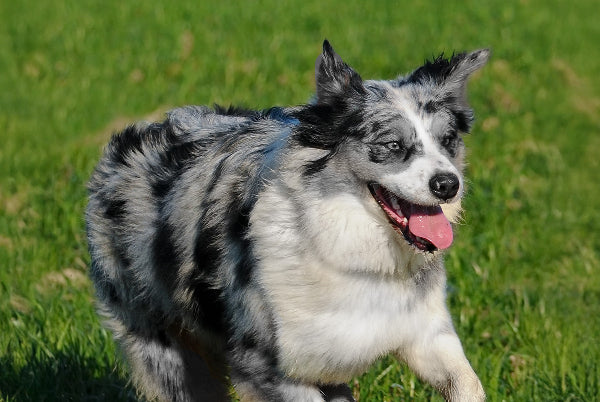
Blue Merle
A marbled mix of greys, blacks, and white, often with striking blue or amber eyes.
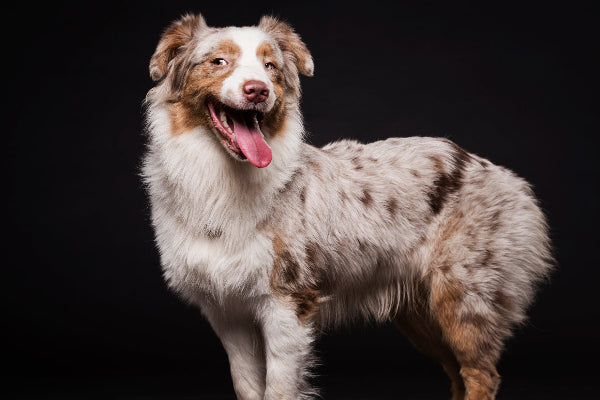
Red Merle
Similar marbling in shades of copper, red, and white.
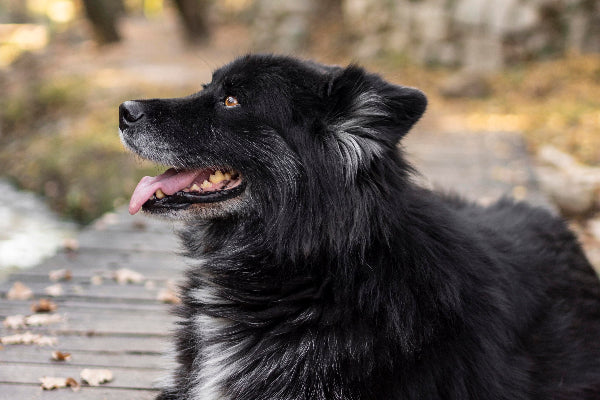
Black and White (Bi-Colour)
Classic and clean. Black base with white accents.
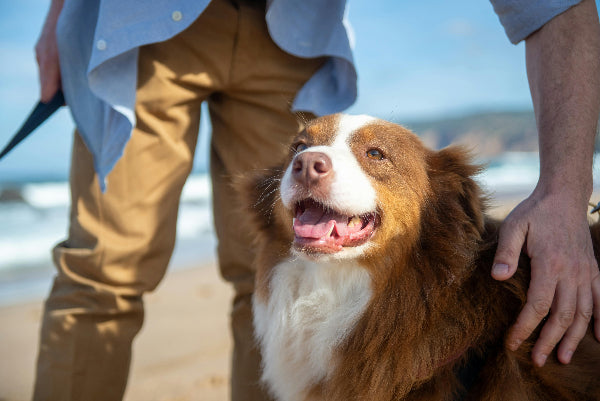
Red and White (Bi-Colour)
Rich, coppery red paired with white markings.
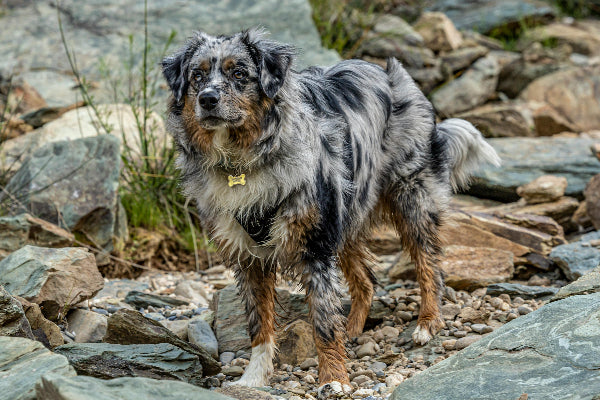
Black Tri-Colour
Black base with tan points and white accents.
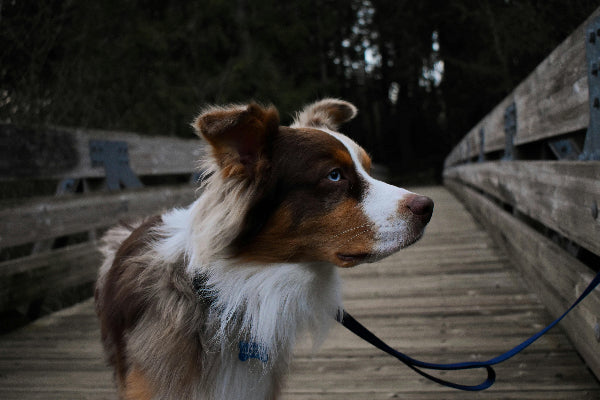
Red Tri-Colour
Reddish coat with tan points and white markings.
Affectionate with family
Good with kids
Social doggos
Playfulness
Australian Shepherd Temperament & Personality
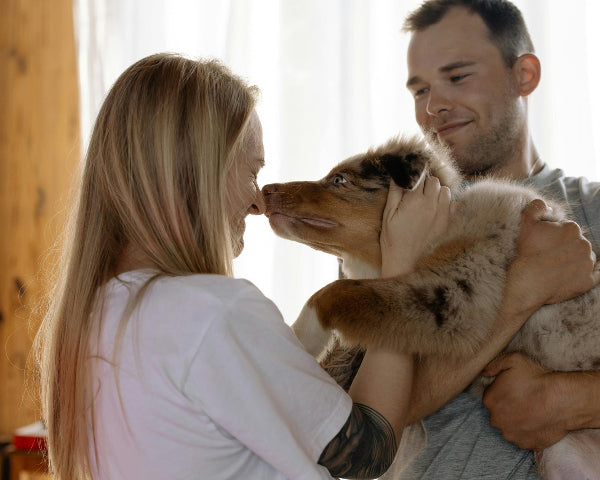
SMILE! If you’ve ever met an Aussie, you might’ve been greeted with a full-on toothy grin. Yep, many Australian Shepherds are known to "smile," especially when they’ve been caught mid-mischief. It’s one of the quirks that makes this breed so loved: a working dog with personality to match its performance.
They are:
- Highly intelligent: Aussies are quick learners and love mental challenges. They pick up commands fast and thrive in obedience, agility, and herding activities.
- Full of energy: This isn’t a couch potato. Aussies need daily physical and mental exercise or they’ll find their own (less ideal) ways to stay busy.
- Loyal and people-focused: They form deep bonds with their humans and often follow them from room to room.
- Natural herders: Expect herding instincts, especially around kids, other pets, or anything that moves.
- Protective but not aggressive: They’ll alert you to strangers, but proper training helps prevent over-guarding.
How They Interact with Children, Strangers, and Other Pets
With children:
They’re playful and protective, but their herding instinct can show up as nipping or circling. It’s not aggression; it’s just their brain saying, “Let me help manage this chaos!” Always supervise play and teach kids how to engage with your furry friend respectfully.
Openness to strangers:
On the scale, Aussies land more on the reserved side. They’re not likely to run up to every new person with tail wags and kisses. But once trust is earned, they’re incredibly affectionate and loyal.
With other dogs:
They generally get along well, especially if socialised early. They prefer dogs who match their energy and play style, too much pushiness or passivity might throw them off.
Socialisation Strategies to Prevent Herding Behaviour
One of the biggest challenges with Aussies is managing that strong herding drive, especially around young kids who squeal, run, and dart about (aka irresistible triggers for herding).
How to guide your Aussie into being a calm, kid-friendly companion:
- Start early: The prime socialisation window is 8 to 16 weeks. This is when your pup is soaking in the world, so make every interaction count. This includes kids, crowds, different surfaces, noises, and routines.
- Reward calm behaviour: When your Aussie chooses not to chase, nip, or overreact, praise them. Catching good behaviour in the act helps shape what sticks long-term.
- Redirect herding instincts: If you spot them crouching, stalking, or nudging kids, gently interrupt and guide them toward a toy, a task, or a place to settle.
- Teach a solid “leave it” or “place” command: These cues help your dog disengage when they’re getting too fixated.
- Avoid chaos early on: Dog parks and wild group settings can be overwhelming. Controlled, calm meetups are much more effective for building confidence.
Behaviour Challenges in Australian Shepherd
An under-stimulated Australian Shepherd will suffer from boredom and anxiety. They will get creative, and that usually means chewed-up shoes or backyard landscaping. Exercise Requirements to Prevent Boredom and Anxiety:
- Daily minimum: 60 to 90 minutes of physical exercise.
- Mix it up: Long walks, off-lead fetch, agility drills, or a game of Frisbee will all work wonders.
- Mental workouts: Obedience sessions, puzzle toys, and nose games help tire out that busy brain.
- Jobs to do: These dogs love having tasks; think trick routines, herding classes, or dog sports like flyball.
Need enrichment ideas? Check out our top puzzle toys for dogs and training reward treats on the Petzyo shop.
Australian Shepherds Lifespan & Health Issues
Australian Shepherds generally enjoy a robust lifespan of 12–15 years, which is typical for medium-sized breeds. Their overall health is good when properly cared for, but they are prone to specific genetic conditions that require attention.
Common Health Problems in Australian Shepherds
The common health issues in Australian Shepherds primarily stem from genetics, as they are often linked to inherited traits or mutations, though environmental factors can also play a role in some cases. Below is a breakdown of the major health concerns and their origins based on the provided information:
1. Drug sensitivities
Some individuals may be sensitive to high doses of parasite prevention medications, sedatives and anticancer therapies due to a mutation in the MDR1 gene. A genetic test is available to identify the issue and guide dose changes, if needed.
2. Hip Dysplasia
Affects the joint structure and can lead to arthritis. Look for signs of limping or stiffness. PennHip X-rays can screen for signs of hip dysplasia in young dogs and puppies.
3. Epilepsy
Causes seizures. Usually manageable with medication once diagnosed.
4. Progressive Retinal Atrophy (PRA)
A genetic eye disease that leads to vision loss. Regular eye checks help detect early changes.
5. Collie Eye Anomaly
A hereditary issue that may affect vision, usually diagnosed in puppies around 8 weeks of age.
6. Deafness
Especially common in merle-coated dogs with blue eyes. Puppies should be hearing-tested early.
Routine Veterinary Care and Preventive Health Measures
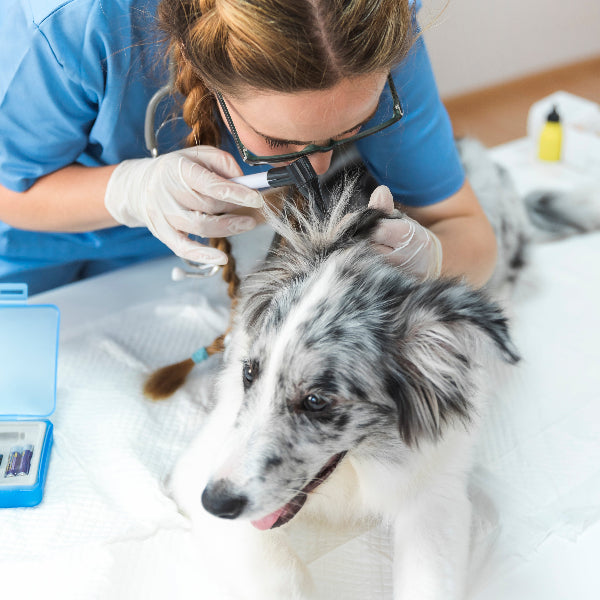
Australian Shepherd Nutrition & Diet Guide
Australian Shepherd were bred to herd, run, and think, so a sedentary lifestyle just won’t cut it. They need purpose, structure, and plenty of action to stay happy and healthy. Australian Shepherds burn a lot of energy, so they need food that keeps up.
Few things to note:
- Portion control: Active adults generally need 1.5 to 2.5 cups of premium kibble daily, split into two meals. Adjust based on age, weight, and exercise.
- Slow-feed bowls: If your Aussie gulps food, use a slow-feeder to aid digestion and reduce the risk of bloat.
- Hydration: Always provide access to fresh water at all times, especially after running, training sessions, or playing in warm weather.
Best Diet for an Australian Shepherd
Aussies burn serious energy, so their food needs to fuel both body and brain.

High-quality protein. Aim for animal-based protein as the first ingredient, it supports muscle strength and energy levels.

Sustained energy release food. Low-GI ingredients, such as brown rice and non-starchy vegetables like broccoli, are best suited for dogs with high energy needs.

Healthy fats, such as Omega-3 and Omega-6 fatty acids, help maintain a glossy coat and support joint health.

Packed with superfoods like turmeric, blueberries, and flaxseed.
Managing Weight and Ensuring a Balanced Activity Level
Despite their lean look, Aussies can gain weight if activity dips or feeding isn’t adjusted.
- Weigh portions: Use a scale or measuring cup to avoid overfeeding.
- Monitor treats: Keep them to training only and adjust meals if you’re giving extras. A good rule of thumb is to stick to no more than 10% calories from treats.
- Body check: You should be able to feel, but not see the ribs; the waistline should be visible from above.
- Balance downtime: Aussies need rest, too! Build in quiet time and calm activities, such as gentle leash walks or lick mats.
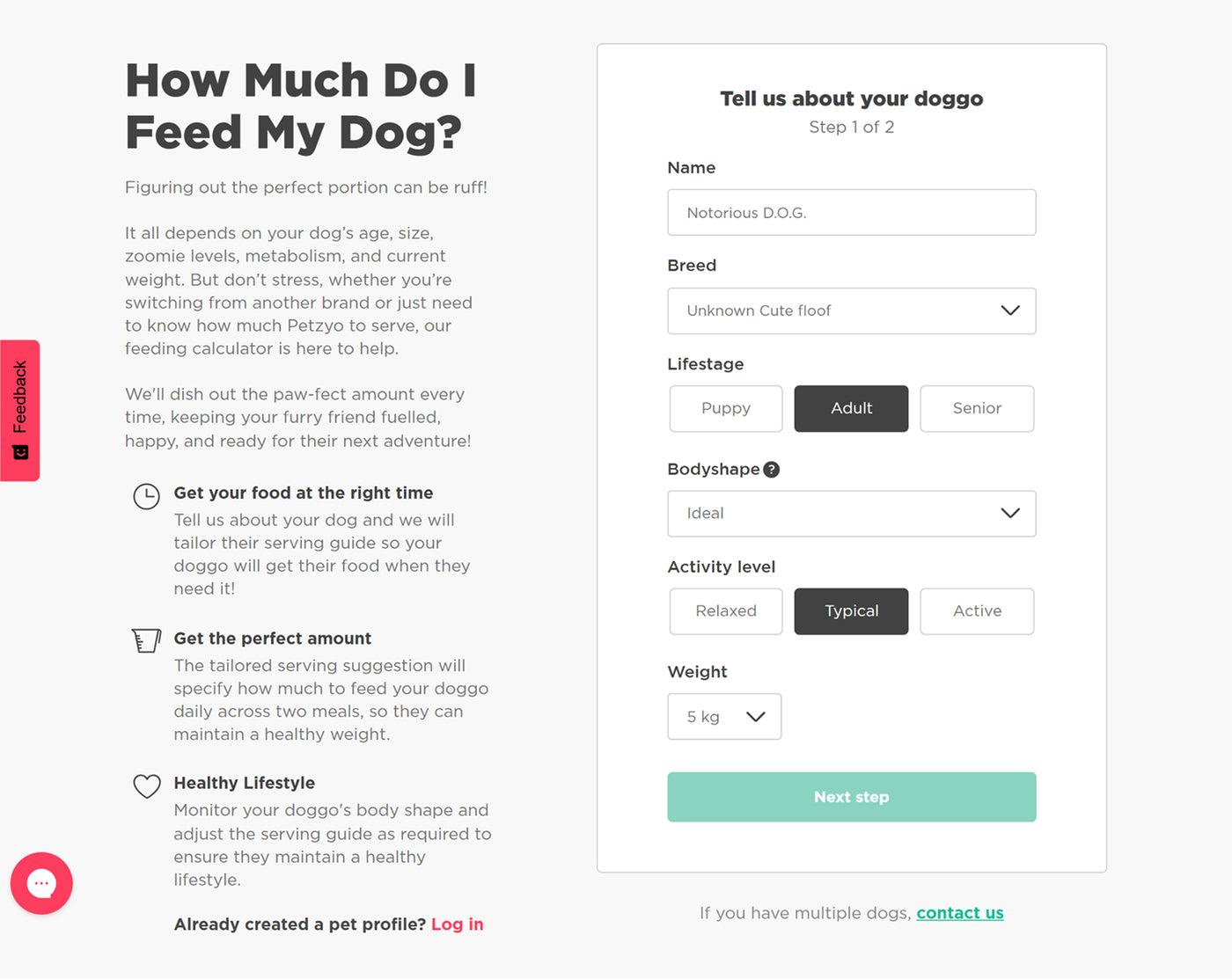
Remember: Healthy weight starts with a healthy gut. A properly formulated diet is your first and most powerful tool to prevent long-term health issues. That’s why we’ve made it our mission to create premium dog food that supports Australian Shepherds from the inside out—because healthy food makes a happy dog.
Shedding Amount
Drooling
Coat Grooming Needs
Trainability
Mental Stimulation Needs
Australian Shepherd Grooming & Maintenance
Staying on top of grooming, health checks, and preventative care will help keep your four-legged mate feeling great from head to tail.
Grooming Requirements
A well-brushed Aussie equals a cleaner house and a happier, itch-free dog.
- Brushing: 2–3 times a week is ideal to keep tangles at bay and manage moderate year-round shedding.
- Heavy shedders during season changes: Expect blowouts in autumn and spring. Daily brushing during these times helps reduce fur tumbleweeds inside.
- Use a slicker brush or deshedding tool: These get right down to the undercoat and help reduce matting.
- Don’t shave: Their coat helps regulate temperature; removing it can do more harm than good.
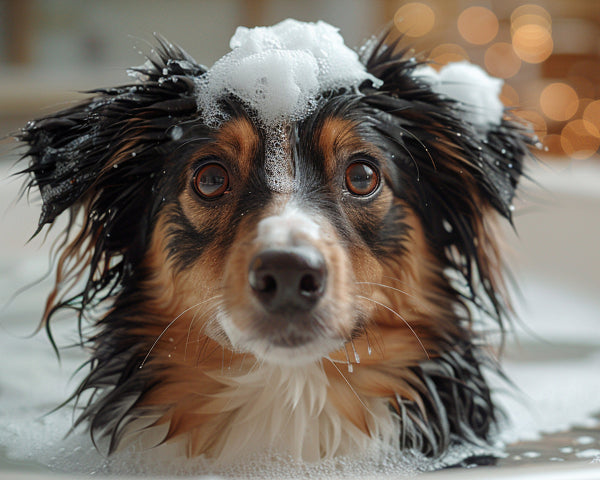
Bathing Frequency and Hygiene Tips
You don’t need to go overboard with baths, but regular hygiene matters.
- Bathing: Once every 6–8 weeks or when they’re dirty. Overbathing can dry out their skin.
- Use a dog-specific shampoo: Look for gentle, pH-balanced formulas that support skin and coat health.
- Ears and eyes: Wipe weekly with a damp cloth. Check for redness, discharge, or odour, early signs of infection.
- Nails: Trim every 3–4 weeks. If you hear them clicking on the floor, it’s time.
- Teeth: Brush 2–3 times per week and use dental chews in between to reduce tartar.
Training & Exercise Needs for Australian Shepherds
Training this dog breed isn’t just about good manners; it’s about channelling their energy and intelligence into something productive and rewarding.
Obedience Training and Mental Stimulation Techniques
Obedience training is essential for an Australian Shepherd, and it goes hand in hand with mental exercise.
- Start early: Commands like sit, stay, and recall should be part of your puppy’s first few weeks at home.
- Keep it fun: Short sessions (5–10 minutes) with treats, praise, or toys work better than long drills.
- Use food puzzles and games: Activities like scent work or hide-and-seek keep their brains just as busy as their legs.
- Assign tasks: Teaching them to help around the house (yes, really!) gives their natural instincts a safe outlet.
Best Training Methods for First-Time Aussie Owners
New to dog training? No worries. Aussies are eager learners, but they need structure, consistency, and clear communication from day one.
- Positive reinforcement is key: They respond best to praise and rewards, not raised voices or corrections.
- Stay consistent with cues: Choose one word per command and stick with it, no switching between “down” and “lie down.”
- Set house rules early: From jumping on couches to how they greet visitors, create boundaries and stick to them.
- Build a strong start: If you're starting from scratch, our "foundation guide for puppy training" is the perfect place to begin. It covers everything you need to raise a well-mannered pup from day one.
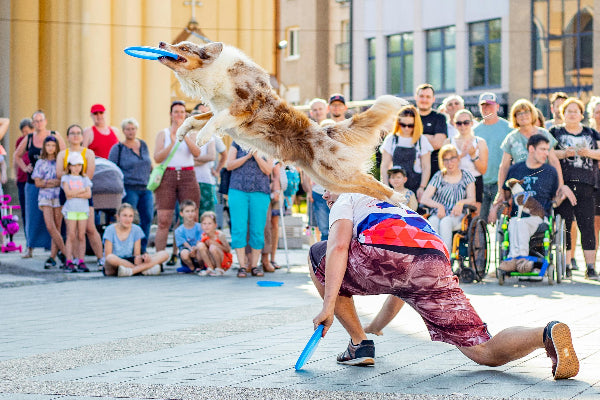
Managing High Energy and Avoiding Destructive Behaviours
Australian Shepherds are smart and high-energy, which means if they’re not busy, they’ll invent their own entertainment.
- Daily exercise isn’t optional: Think 60–90 minutes of walking, play, and training each day.
- Tire them out mentally: Use trick training, puzzle toys, or obedience games to work their brains.
- Manage freedom indoors: Until they’re fully trained, avoid giving them the run of the house to prevent bad habits.
- Crate training is helpful: Give them a safe, calm space to decompress, especially after activity.
If you’re seeing signs of anxiety, stubbornness, or over-the-top behaviours despite consistent training, it might be time to level up. Our guide on "Signs Your Dog Needs Professional Training AKA “K9 Training" can help you recognise when it’s worth calling in the pros.
Cost & Ownership Considerations
The initial cost of an Australian Shepherd puppy from a reputable breeder typically ranges from $2,000 to $7,000 AUD. However, prices can vary based on factors such as the breeder's reputation, the puppy’s pedigree, specific coat colours, and geographical location. Adopting an Australian Shepherd from a rescue organisation can significantly reduce the upfront cost.
In addition to the purchase price, potential owners should also budget for ongoing expenses, which include food, routine veterinary care, vaccinations, toys, a bed, and possibly insurance or an emergency fund to ensure the health and well-being of this active and intelligent breed.
Australian Shepherd in an Apartment
Life with an Aussie is anything but boring. These dogs thrive on structure, stimulation, and a strong bond with their humans.
While they can adapt to living in an apartment, it's not ideal unless you are a very active owner. Australian Shepherds are high-energy dogs that require space to move around and a daily outlet for their intelligence.
Australian Shepherds are high-energy dogs who need space to move and a daily outlet for their smarts.
If you live in an apartment:
- Schedule multiple walks every day. Include off-lead playtime in secure parks or yards.
- Use puzzle feeders and trick training to keep their minds working.
- Avoid leaving them alone for long stretches. Boredom = barking, chewing, or pacing.
With a solid routine, enough mental stimulation, and your time and attention, Aussies can live in small spaces, but only if their big needs are met daily.
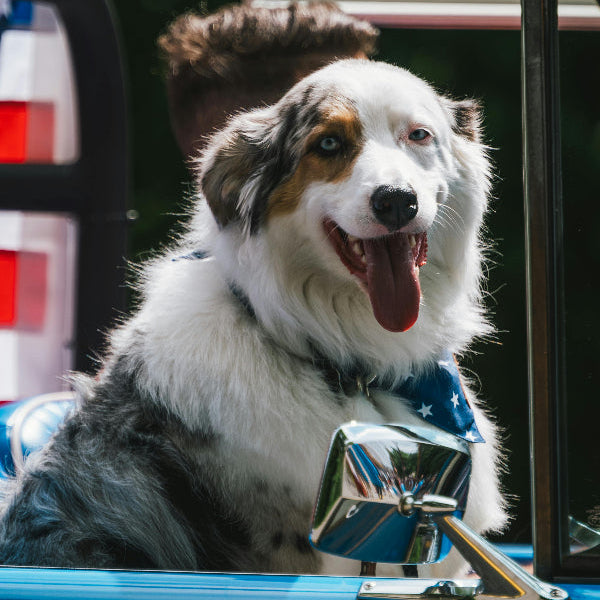
Travelling with an Australian Shepherd
Australian Shepherds make excellent travel companions, but only when their safety and comfort are a priority.
In the car
- Use a travel harness or a secured crate to prevent movement
- Pack water, a blanket, and their favourite chew toy
- Stop every 2–3 hours for toilet breaks and leg stretches
- Never leave them in a hot car, even for a few minutes
Flying with an Aussie
- Choose direct flights whenever possible to minimise stress
- Use an airline-approved crate with proper ventilation
- Add a familiar-smelling blanket or toy to ease anxiety
- Confirm your dog’s microchip and ID are current before travelling
